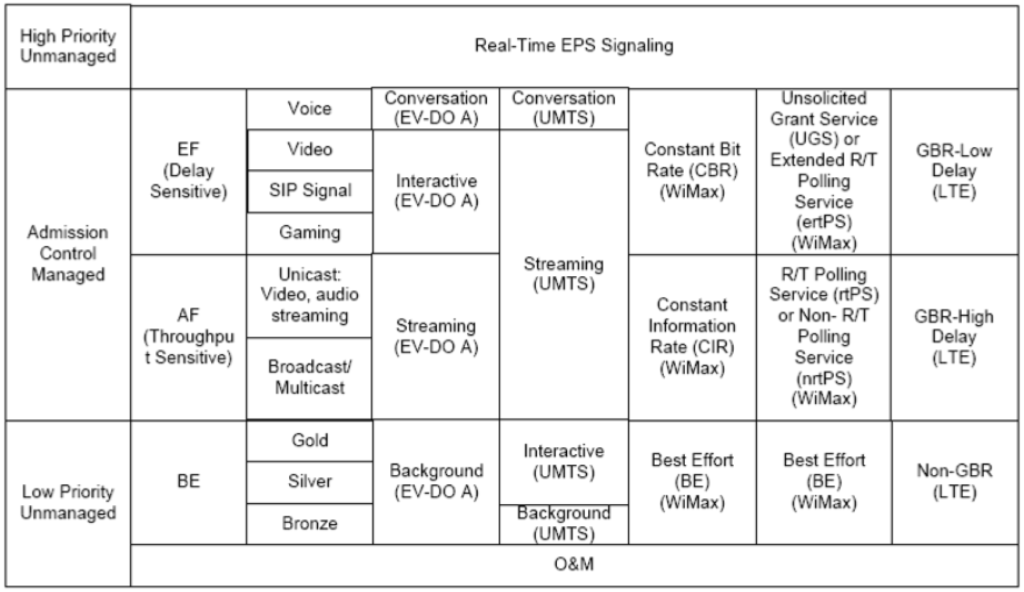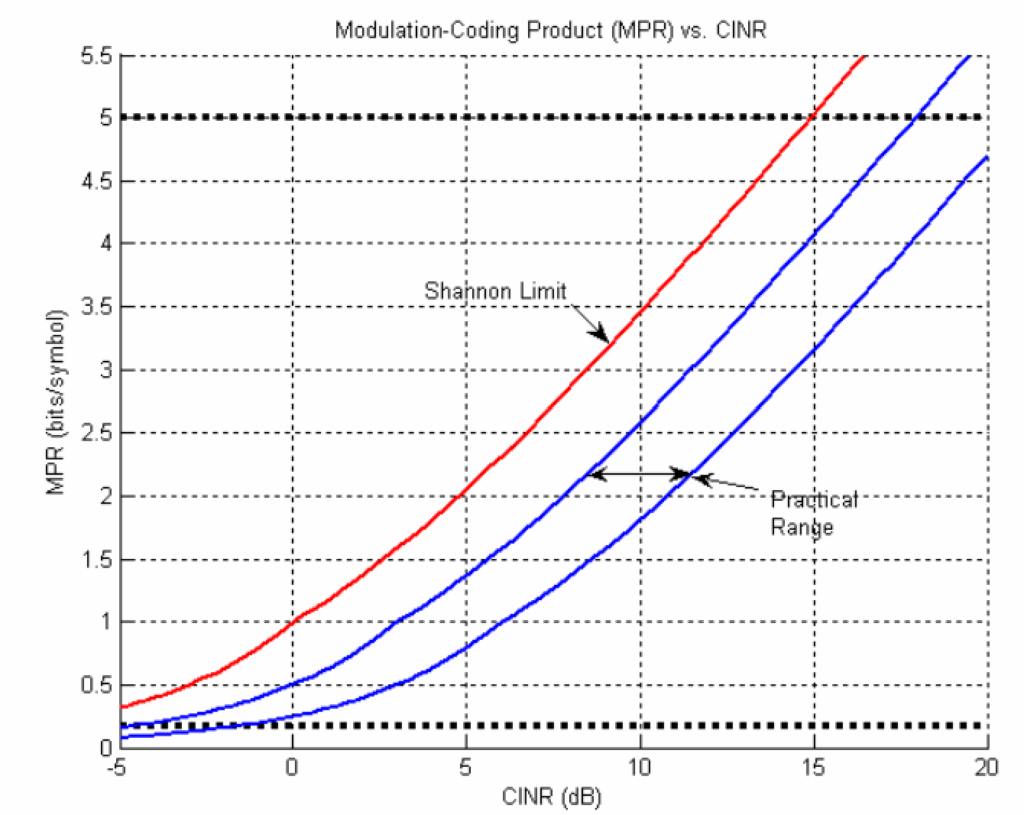The LTE MAC scheduler is designed to efficiently deliver data services including voice, data, and video over a time-varying broadband wireless channel. It must efficiently allocate available resources in response to bursty data traffic and time-varying channel conditions.
The scheduler is implemented at the MAC layer and located at the eNodeB to enable a rapid response. The data packets are associated with service flows that have well defined QoS parameters so that the scheduler can prioritize their transmission.
The scheduler will use CQI, ACK/NACK and, for the UL, power headroom report (PHR) information to choose the appropriate coding and modulation for each allocation. The MAC supports frequency-time resource allocation in both the DL and UL on a per-TTI (i.e. 1 ms slot) basis. The fast and fine granular resource allocation allows for superior QoS for data traffic.
The traffic will be divided into three types: QoS managed bearer traffic that is admission controlled (Guaranteed Bit Rate or GBR), unmanaged bearer traffic which is not admission controlled (non-GBR), and unmanaged non-bearer traffic. Referring to Figure below, the following observations can be made:
- Traffic can be divided into that which is managed via Admission Control (GBR) and that which is unmanaged.
- Signaling has the highest priority and O&M the lowest priority.
- Within the GBR traffic type, Expedited Forwarding (EF) is used for delay sensitive service flows (e.g. voice) and Assured Forwarding (AF) is used for service flows that are sensitive to packet throughput (e.g. streaming video). EF service flows will have a higher priority than AF service flows.
- BE is for service flows where performance is not guaranteed and delay and packet delivery requirements are least stringent.
- Mappings to other traffic classes defined for EV-DO, UMTS, and WiMAX are provided.

In simple form, the scheduler prioritizes user flows based on a ratio of achievable to average actual throughput for each user. In the equation below, i is a user and ri is the prioritization metric for that user. Spectral efficiency (SE) represents the achievable throughput while T represents the average actual throughput. The parameters α and β are used to control scheduling fairness.

The spectral efficiency for the user is derived as a function of the CINR. The relationship
of SE and CINR was discussed before, where SE was represented in MPR. This relationship (refer to Figure below MPR vs. CINR) can be characterized by an equation of the following form.

SEi = Alog(1 + B x CINR)
When parameters A and B equal 1, then the relationship corresponds to the ideal (read “non-real world”) limit of the Shannon capacity.
As stated earlier, the α and β parameters are used to control scheduling fairness.
When α = 1 and β = 0, then the scheduler would be biased towards always prioritizing users with the best signal. In this approach, it is all about maximizing what is achievable. This is termed “Max C/I” and would show highest overall capacity, but this would come at the expense of poorer signal users who would experience “starvation”.
When α = 0 and β = 1, then the scheduler seeks to deliver equal bit rate to all users. This approach doesn’t care at all about what is achievable and seeks only to equalize throughput among all users at the expense of throttling the good signal user to levels of performance far below that of which they are capable. Mathematically, the sector capacity is approximated by the harmonic mean of the MPR distribution (i.e. the achievable rates).
When α = 1 and β = 1, then the scheduler is balanced in such a manner as to deliver to different users a throughput that is proportionally equivalent relative to that which is achievable by the user. This form of scheduling is termed proportionally fair (PF). As an example, it might be observed that all best-effort users would be driven to a throughput which represents 80% of that which they are capable.
The user with an MPR of 2 and the user with an MPR of 5 would both experience a throughput which is 80% of that which they are capable. Mathematically, the sector capacity is approximated by the arithmetic mean of the MPR distribution (i.e. the achievable rates) which is larger than the harmonic mean.
When γ (equal to α/β) > 1, then PF is biased towards the achievable (i.e. towards spectral efficiency) and it yields higher average performance (tending towards “Max C/I”). Conversely, when γ < 1, then PF is biased towards the average actual throughput and it yields lower average performance (tending towards “equal bit rate”).
With PF settings (α = β = 1), full buffer testing is likely to achieve average spectral efficiencies as predicted by the arithmetic mean of the MPR distribution. Conversely, VoIP-only testing (i.e. delay sensitive traffic) is likely to achieve average spectral efficiencies consistent with the harmonic mean of the MPR distribution.
Note that this would be true even with PF settings since delay sensitive traffic is prioritized specially.
Finally, web browsing and ftp (i.e. delay tolerant services) traffic is likely to produce results tending toward the harmonic mean rather than the arithmetic mean even with PF settings. Full buffer traffic yields higher traffic levels because of its non-real world characteristic of continuous data.
Under these conditions, the scheduler behaves optimally, i.e. it has the maximum flexibility to prioritize service flows according to its parameterization. Conversely, real world data service flows have gaps in their data streams which lead to the scheduler behaving more inflexibility (i.e. needing to honor data that is present regardless of its QoS level) and this lowers spectral efficiency.
Because maximum system capacity may be obtained by providing low throughput to some users, it is important that all subscribers (i.e. fixed or mobile) be provided with a minimal level of throughput. This is termed fairness. In multi-users simulations, the user throughput CDF or a specific percentile of the distribution can be used to evaluate fairness.
For example, the 5th percentile of the distribution can be used to represent the cell edge performance of low signal users. If the user throughput for this percentile is greater than a criterion of 10% of the average user throughput, then fairness is achieved.
Some attributes of the scheduler design during initial phases include the following:
- For non-GBR traffic, PF metrics are used for prioritization. Default values for α and β are 1.0 and 0.75, respectively, which is slightly biased towards prioritizing spectral efficiency.
- GBR traffic is managed separately from non-GBR and a “user fairness” (UF) scheduler will be used for prioritization (i.e. strict FIFO).
- For non-GBR traffic, the operator can specify a mix of both PF and UF scheduling. (UL only)
- Although BE is not guaranteed, the operator can constrain QoS (non-BE) traffic to a specific percentage of the bandwidth at admission and thereby reserve capacity for BE traffic. Lower level details of actual scheduler implementation are beyond the scope of this document. The focus of this discussion has been to show how different scheduler parameterization can impact the average sector MPR and capacity.